Schon vor Corona hätte der deutsche Staat mehr als 58 Milliarden Euro pro Jahr sparen müssen
→ Bundesfinanzministerium: “Vierter Bericht zur Tragfähigkeit der öffentlichen Finanzen”, 2016
Nicht nur die Bundesregierung lässt rechnen (ohne die Schlussfolgerungen daraus zu ziehen), auch die EU. Deshalb heute der Bericht der EU-Kommission. Schlechte Nachricht Nummer 1: Auch laut EU haben wir eine Lücke. Schlechte Nachricht Nummer 2: In den meisten anderen Ländern sieht es nicht besser aus.
Schauen wir es uns an:
Zunächst die Feststellung, dass die meisten Bevölkerungen in den kommenden Jahren schrumpfen. Große Gewinner sind UK und auch Frankreich. Besonders dramatisch ist der Rückgang der Erwerbsbevölkerung:
Dann die wenig verwunderliche Folge, dass immer mehr Alte von den Aktiven finanziert werden müssen: “The old age dependency ratio, population aged 65 and over as a proportion of the population aged 15-64, will rise from a value of 30% in 2016 to 51% in 2070 (with a peak of 52% in 2060). In the euro area, the ratio will be 31% and 52%, in 2016 and 2070, respectively. Most of this increase is driven by the very old-age dependency ratio (people aged 80 and aboverelative to those aged 15-64) which is rising by 14 pps. (8% to 22%) over this horizon.”
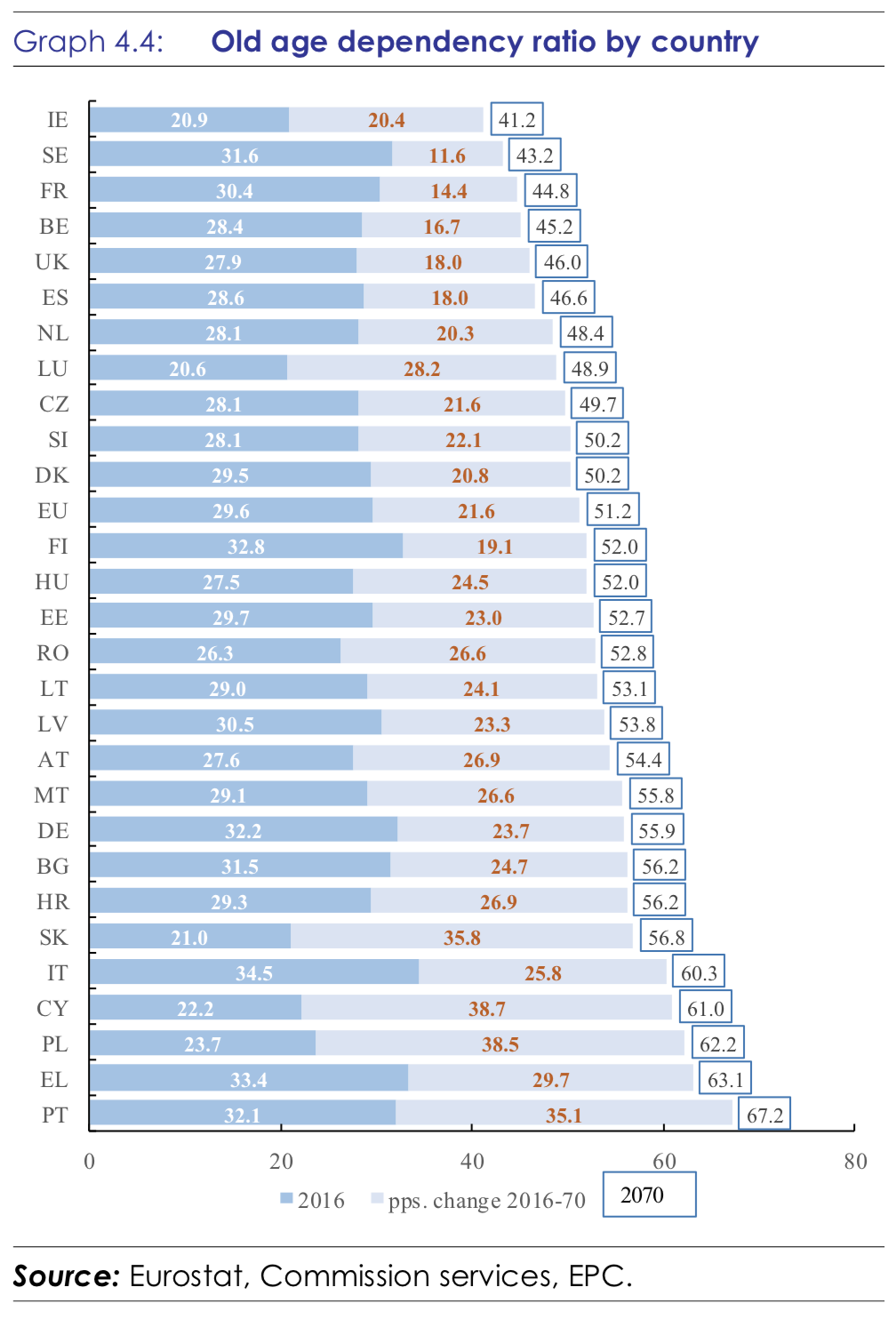 Wichtig hier: Welche sonstigen Belastungen muss diese junge Generation noch schultern? Zuwanderung in Sozialsysteme? Überstürzte Energiewende? Denn diese Lasten kommen zusätzlich auf die junge Generation zu, die zudem stärker aussieht, als sie ist. Da ist zum einen der hohe Anteil mit Migrationshintergrund, der im Schnitt weniger gut ausgebildet ist, weniger arbeitet und verdient. Da ist zum anderen der Niedergang des Bildungswesens bei gleichzeitig verfallender Infrastruktur.
Wichtig hier: Welche sonstigen Belastungen muss diese junge Generation noch schultern? Zuwanderung in Sozialsysteme? Überstürzte Energiewende? Denn diese Lasten kommen zusätzlich auf die junge Generation zu, die zudem stärker aussieht, als sie ist. Da ist zum einen der hohe Anteil mit Migrationshintergrund, der im Schnitt weniger gut ausgebildet ist, weniger arbeitet und verdient. Da ist zum anderen der Niedergang des Bildungswesens bei gleichzeitig verfallender Infrastruktur.
So oder so hat dieser Wandel eine negative Wirkung auf die wirtschaftliche Entwicklung: “The reduction in working-age population will put pressure in the labour supply that will fall accordingly. Working longer and more, with an increase in participation rates especially of older population, may not be enough to compensate for the drop in working-age population. (…) In the EU, participation rates is projected to increase over the long term, from 77.5% in year 2016 to 80.7% in 2070 for the group 20-64. The increase would be more intense for women (from 71.4% to 76.9%) and older people 55-64 (from 59.1% to 71.3%). The employment rate would increase accordingly in the population group 20- 64, with an increase for the European Union of 4.7 pps., from 71.1% in 2016 to 75.8% in 2070. The net effect of declining working-age population and higher employment rates is still negative for employment in the European Union (…).” – bto: Auch das ist alles bekannt.
Führt zu der Frage, ob die Produktivität entsprechend steigt, um das zu kompensieren: “In the (…) baseline projection, it is assumed that all countries will converge to a labour productivity growth rate of 1.5% in the long term (corresponding to a TFP growth rate of 1%). (…) This assumption could be on the optimistic side, given historical trends in TFP growth. A risk scenario was therefore carried out, where convergence to a labour productivity growth rate of 1.1% was assumed instead (TFP growth of 0.8%).” – bto: Zurzeit haben wir immer geringere Produktivitätszuwächse und Bildung. Und fehlende Investitionen sprechen eher für geringere Zuwächse in der Zukunft. Man beachte, wie mau die Wachstumsaussichten für Deutschland sind:
Und dann kommen wir zur einfachen Mathematik: “The ageing process has a direct effect on the public finances and will lead to higher age- related expenditure. In the European Union, total ageing cost as percentage of GDP (incorporating pensions, healthcare, long-term care, education and unemployment benefit projections) will increase by 1.7 pps. in the period 2016-2070, from 25.0% to 26.6% (see Graph 4.8).”
Kommen wir nun zu den Folgen für die öffentlichen Haushalte: “Fiscal sustainability in the long term relates to the achievement of the government’s intertemporal budget constraint. This constraint, which is also known as the solvency condition, refers to the capacity of a country to meet its net debt obligations, over an infinite horizon, with a stream of future primary surpluses. Other things equal, the greater the projected cost of ageing, the more difficult it is to fulfil the intertemporal budget constraint, as higher revenue (in present terms) is required to cover these additional costs, in addition to the other non-interest expenditure and the cost of servicing the outstanding debt.”
“The S2 indicator is the central element of the long-term sustainability analysis. Using the infinite version of the government budget constraint, the S2 fiscal sustainability gap indicator measures the budgetary adjustment that would ensure sustainable public finances in the long term. Specifically, this indicator shows the upfront adjustment to the current structural primary balance (subsequently kept constant at the adjusted value forever) that is required to stabilise debt-to- GDP ratio over the infinite horizon, taking into account also any additional expenditure arising from an ageing population that, over time, add up to the current structural primary balance.” – bto: Also ist es der Betrag, den ich heute zur Seite legen müsste, damit es in Zukunft zu keinem weiteren Anstieg der Ausgaben kommt.
“The S2 indicator points to sixteen Member States at high or medium fiscal risk in the long term. (…) Graph 4.12 shows for each Member State a disaggregation of the S2 indicator in terms of the initial budgetary position (IBP) and the three components of the long-term cost of ageing (CoA), namely pensions, healthcare, long-term care, and other determinants. The negative contribution of government spending on health and long-term care to the sustainability gap is particularly high (…). – bto: Da könnten unsere Politiker jetzt sagen, dass wir, verglichen mit den anderen, gut dastehen. Nur ist das zum einen nicht der richtige Vergleich, zum anderen dürften gerade die neuesten Zusagen die Finanzierungslücke dramatisch vergrößert haben. Außerdem sind die Haushaltsüberschüsse einer einmaligen, nicht nachhaltigen wirtschaftlichen Lage geschuldet. Gepaart mit den unzureichenden Investitionen ergibt sich wohl ein deutlich schlechteres Bild.
Wie schlecht es um Deutschland steht, sieht man daran, dass wir einen erheblichen Gap haben, obwohl wir im laufenden Haushalt die „schwarze Null“ feiern. Nehmen wir diese als das, was sie ist, nämlich eine vorübergehende Lage, die zudem nicht genutzt wurde, dann liegt die Lücke deutlich höher:
Entsprechend mehr müssten wir zur Seite legen: “The overall size of the required structural primary balance (RSPB) is informative about the overall fiscal policy that needs to be sustained to close the sustainability gap. The RSPB is the sum of the structural primary balance in 2020 (i.e. end of forecast period) and the required additional effort measured by S2 to stabilise the debt ratio in the long term. (…) The percentile rank of the RSPB implied by the S2 indicator gives an indication of the degree of the plausibility of the implied adjustment. The RSPB can be benchmarked to the history of primary balances in the EU, hence allowing an assessment of how common (or uncommon) the fiscal position assumed in the projections is, relative to the structural primary balance distribution for all EU countries over 1980-2018. In particular, it indicates where a very large primary balance implied by the S2 is unlikely to be sustained in the long term. The required structural primary balances appear large in BE, CZ, DE, IE, IT, LU, HU, MT, NL, AT, SI and the UK (see Table 4.3).” – bto: Wir müssen die vollen 3,6 Prozent als Basis nehmen, wenn nicht sogar mehr. Übrigens, 3,6 Prozent entsprechen 122 Milliarden, 1,7 Prozent (wenn wir die schwarze Null als nachhaltig betrachten, was sie bekanntlich nicht ist) 58 Milliarden.
Zur Politik: Die nächste Abbildung zeigt nochmals, dass wir, verglichen mit den anderen (Bankrotteuren), besser dastehen. Aber sie zeigt auch, wie schnell sich das Bild verschlechtern kann (Italien!!) und, dass man bei uns in der falschen Richtung unterwegs ist:
Fazit: Es ist und bleibt ein Märchen vom reichen Land, das uns regelmäßig aufgetischt wird. Die Sozialausgaben steigen schon in den guten Zeiten und verschlechtern die Aussichten für die Zukunft weiter. Da nutzt es uns wenig, dass unsere Partner zur Lösung ihrer Probleme mehr Geld von uns wollen. Im Gegenteil!







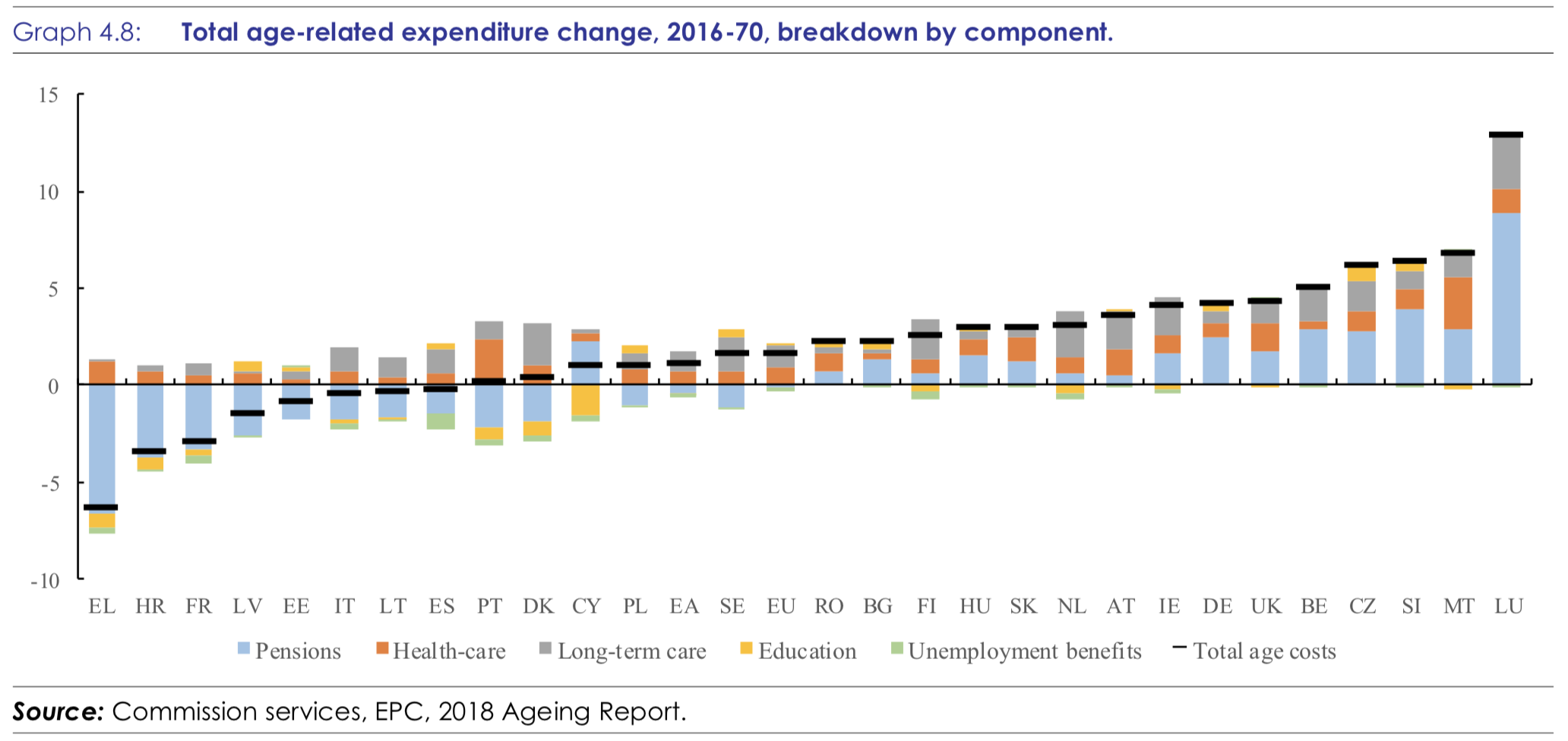
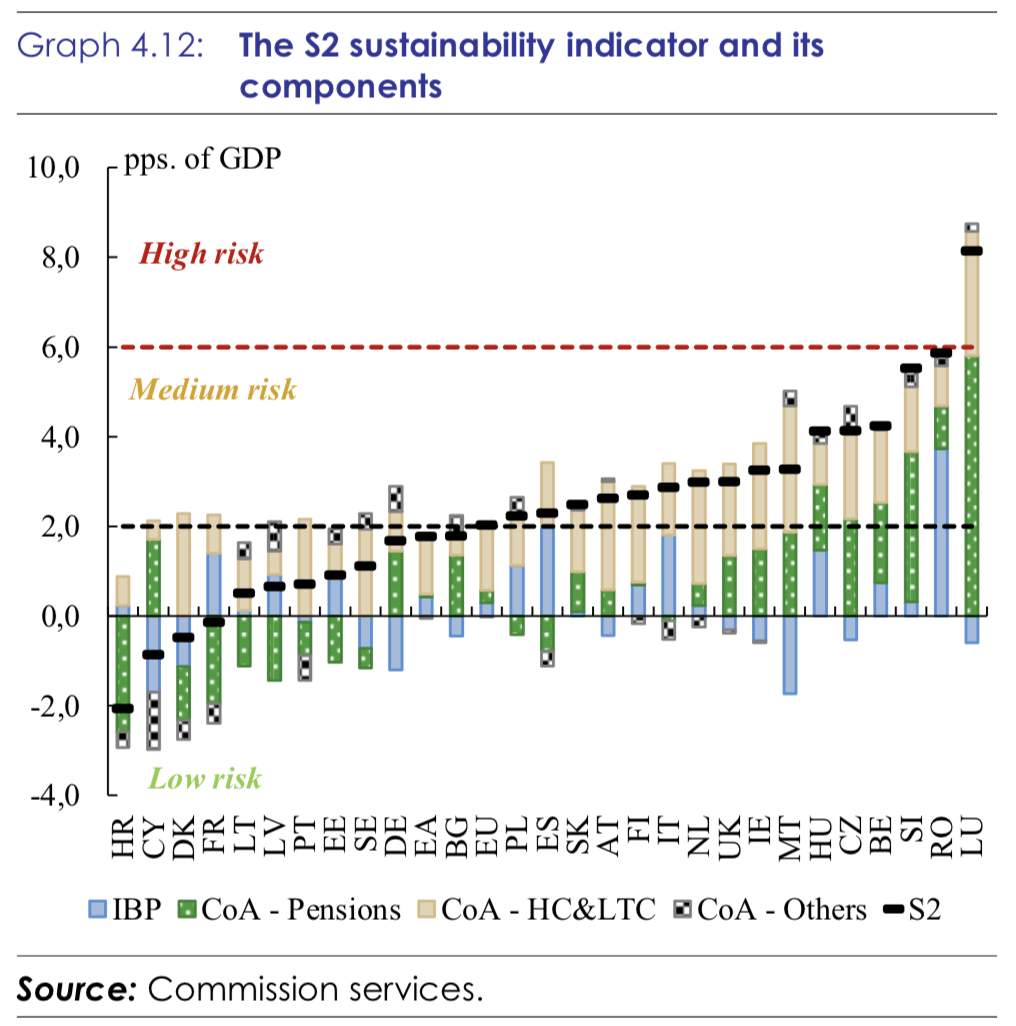

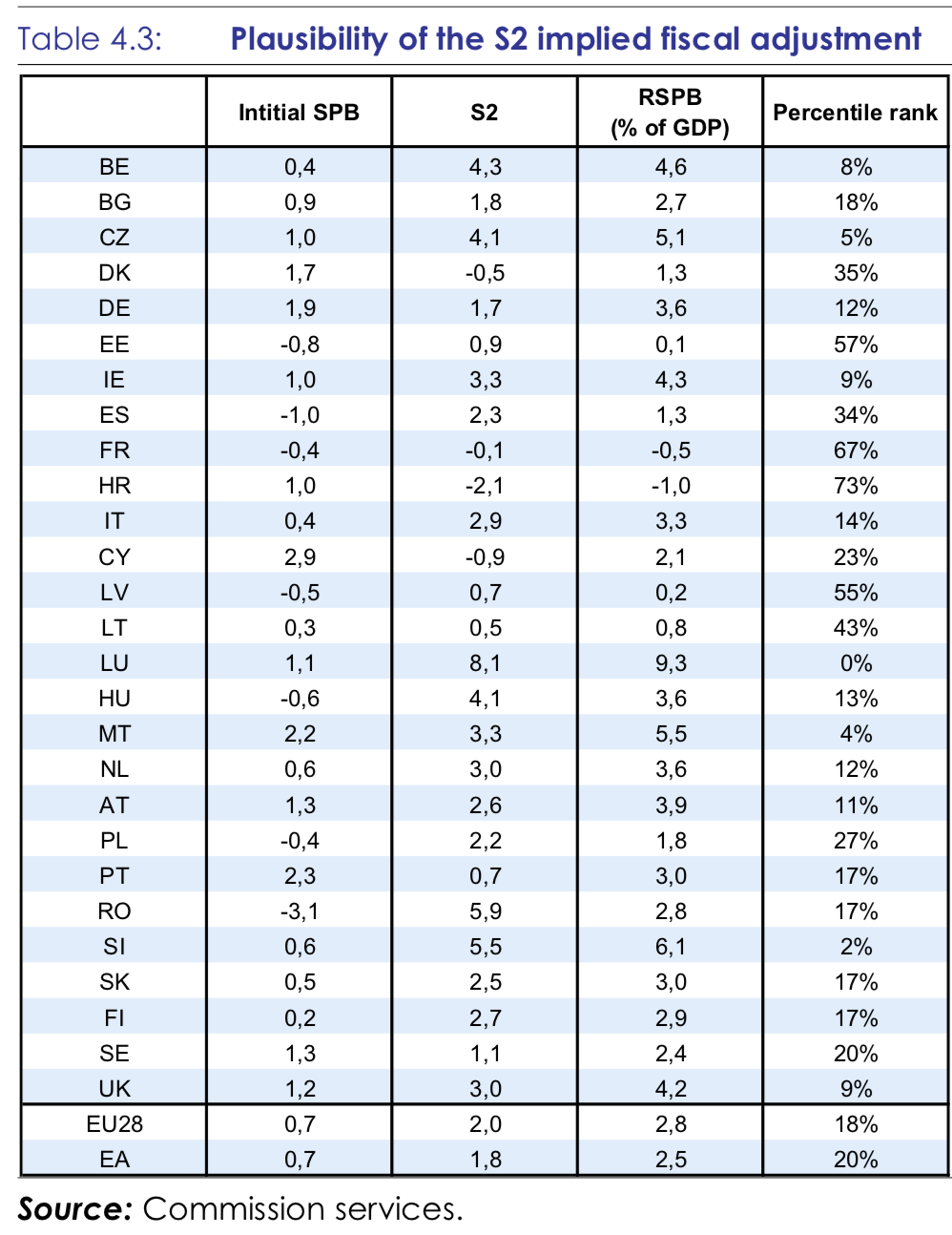
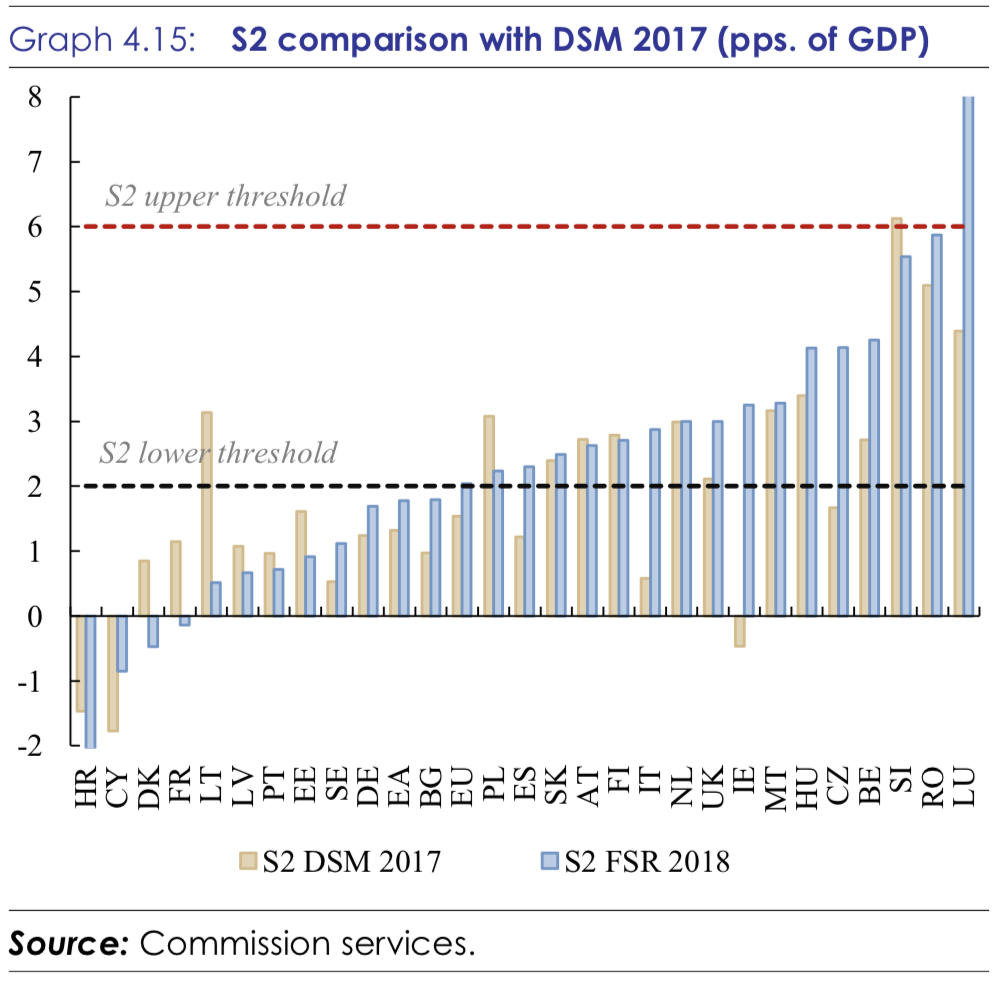



Die Einführung der Doppik ist eine sinnvolle Maßnahme. Man sollte sich aber nicht zu viel davon erwarten. Auf kommunaler Ebene wurde sie bereits 2008/2009 bundesweit eingeführt. Die Akteure bleiben dieselben, die Probleme auch. Es bringt vereinzelt ein bißchen Bewußtsseinsbildung und extrem viel Arbeit für die betroffenen Stellen. Zudem werden die Bilanzen überwiegend ausweisen, dass wir alle PLEITE sind – es muss aber trotzdem weiter gehen.
@ Felix
Die Karawane des Fürstenstaates zieht weiter, sich mit geprägten Gold-, Silber-Münzen, heute wahlweise per Notenbankgeld, Staatsanleihen sonstige Wertpapier- oder Kontosaldeneinbuchungen demnächst CBDC, die für ihr zielloses verprassendes Vagabundieren notwendigen Güter und Leistungen den herstellenden Menschen unter Zwang und Gewalt abzupressen.
Kamerale Einnahmen, doppische Erträge oder Cashflows/Zahlungsströme der Finanzrechnungen, alles wird für deren selbstbezügliche Daseinszustände begrenzungslos weggeschöpft oder umgeleitet.
Es ist wieder Zeit einen neuen Anlauf unter die Völker zubringen.
Dieses vorausschauende Handeln über die “Pleite” hinweg feiern diese Veranstalter der Wirtschaftsräume versteckt und erfinderisch vor jeglicher Rechenschaftslegung und Verantwortungsübernahme konkret ohne Haftung und Ausschluß von der Gestaltung der Gesellschaftsbeziehungen.
Im Gegenteil sie schliessen Unbegeugsame aus oder überwachen die wirtschaftliche Handlungsfreiheit bis zum letzten Cent im persönlichsten Winkel der Lebensbereiche.
Die totale Beherrschung der Rechnungsführungs- und Rechnungslegungssysteme ist die hidden agenda der global princess of the money.
Muß das so weitergehen – keine Gesetzmäßig- oder Freiwilligkeit wird je Gültigkeit offenbaren, weil es diese nicht gibt und sie unvollständige unnatürliche nicht tragfähige Bilanzierungen sind.
@ Ruby
Ich sehe dahinter weniger Plan als Planlosigkeit. Das “Dienstpersonal” der Eliten läßt viel Kompetenz vermissen und die durch bloße Angehörigkeit zu den “Oberen Zehntausend” Gehörigen dröhnen sich entweder geistlos voll (Koks, Kaviar, Party) oder fühlen sich selbst nicht wohl mit der Situation.
Mir scheint es ein allzu menschliches Problem zu sein, einfach mit der Welt nicht vernünftig fertig zu werden. Mir würde schon genügen, den Grad an Blödsinnigkeit unter die Schmerzgrenze zu fahren. Vorhin habe ich gelesen, dass die SPD die pauschale Zinsertragssteuer wieder durch den individuellen EkSt-Zinssatz ersetzen will – hätte man noch Zinsen, wäre das schon eine blöde Idee, aber da die Zinsen NULL sind, fragt man sich doch, was mit diesen Leuten los ist, oder?
@ Felix
Für Einkommensvariable Vermögendende wird die Anrechnung mit andere Einkommensarten ein Mega Deal, genau andersherum wie bei Einführung der pauschalierten 25 % KapESt
https://m.zinsen-berechnen.de/abgeltungssteuer/verlustverrechnung.php?dateiname=verlustverrechnung.php
Wer klug ist wird sich das nicht antun:
Schlechte Demographie
Schlechte Zuwanderubgssteuerung
Abgleiten in Staatswirtschaft
Massiver Bürokratismus
Uvm.
Vor fast 100 Jahren hat man Deutschland auch besser den Rücken gekehrt… für 20 Jahre.
Wir reden hier von der Entwicklung bis 2070.
Was in 50 Jahren ist, interessiert in der Bevölkerung nicht – und daher THEMATISIERT es auch KEINE Partei und Regierung.
Und wenn doch, wenn etwa dargelegt wird, dass wir alle länger arbeiten müssten und es auch könnten – also die „depency ratio“ reduzieren könnten –, weil wir gesünder sind und länger leben, ist man hierzulande sofort im politischen Grabenkampf und woanders, in Frankreich z. B., gehen die Leute auf die Straße und destabilisieren die Regierung.
Ich arbeite noch und arbeite gern, und vermute anhand seiner Beiträge, dass Herr Bauer, der älter als ich ist, es auch könnte, wenn er es sollte oder müsste.
Wer sich die Zahlen ansieht, kann jedenfalls erkennen, dass die Entwicklung überall in Europa auf ein Desaster zuläuft.
Demografische Entwicklungen lassen sich eben nicht dadurch ändern, dass man einen Schalter umlegt.
Und richtig:
Die Älteren und Alten werden die Letzten sein, die aus Einsicht freiwillig etwas ändern werden.
Denn es geht ihnen weit überwiegend vor allem darum, es in möglichst guter Gesundheit mit Anfang 60 „GESCHAFFT“ zu haben.
Bemerkung zur Studie:
Ich halte die Berechnung der old age dependency ratio mit Bezug auf 15 bis 64jährige für UNREALISTISCH.
Die 65jährigen Menschen hängen doch nicht von 15-, 16- oder 17jährigen ab.
Diese sind AUCH Abhängige.
Zumindest gefühlt wäre 20- bis 64jährige REALISTISCHER.
Oder wollen wir wieder zu Kinderarbeit zurück?
@Herr Tischer
“Die 65jährigen Menschen hängen doch nicht von 15-, 16- oder 17jährigen ab.”
Naja, früher war es mal so, dass die meisten Jugendlichen mit 15 oder 16 nach 9 Jahren Schule eine Berufsausbildung anfingen und dann tatsächlich zur “working age population” gehörten. Mit “Kinderarbeit” hat das nichts zu tun.
Stellen Sie sich mal vor, wie schlecht die Zahlen aussehen würden, wenn wir die Trends zu Langzeitstudium und Frühverrentung berücksichtigen und stattdessen die Anzahl der 30- bis 60-Jährigen ins Verhältnis zum Rest der Bevölkerung setzen…
@ R.Ott
Teils – teils. Dies ist eine EU-Sudie. In der EU haben wir durchaus noch Lànder, in denen das Arbeitsleben überwiegend noch vor dem 20. Lebensjahr beginnt. Vor vierzig Jahren machten noch 25 % meiner Belegschaft eine Lehrzeit, die nach der Hauptschule, bzw. nach der mittleren Reife (schon ein erheblicher Qualitätsunterschied) begann.
D ist ein Extrembeispiel in der Länge der Studienzeit und wir übertreffen unsere Nachbarn. Das heisst allerdings noch nicht, dass dort das Arbeitsleben (= eigenes regelmäßges Einkommen) früher beginnt, die Studenten schließen eher ab, eine Geldfrage, drücken sich anschliessend noch lange herum mit Gelegenheitsjobs, da die adäquaten Stellen in der Wirtschaft fehlen. Per Saldo ist es also dasselbe, Das Erwerbsleben beginnt mit um die 30.
Das gab es auch schon früher, meine persönlichen Erfahrungen mit solchen “Spätberufenen” waren jedoch katastrophal. Ich entschied mich immer für die jüngsten, auch wenn deren Noten nur mittelmäßig waren, sie ließen sich noch integrieren.
Die Verräter in den Altparteien haben, aufgrund von kurzfristigen persönlichen Vorteilen und purem Machtstreben, unser System auf sämtlichen Ebenen komplett herunter gewirtschaftet; es ist mehr als an der Zeit, dass sich das System um 180° wendet!
Austritt aus der auspresserischen EU, Rückführung aller Wohlstandsmigranten, eine positive Familienpolitik, Förderung von Wirtschaft, Eigeninitiative und Innovation, Rückholung und Ausbau der deutschen Goldreserven und eine Rückkehr zu einer stabilen Währung und wir können diese Wende schaffen!
@ M. Bodenheimer
Sie haben das Problem benannt. Wir werden jedoch keines Ihrer Gegenmittel erleben :
Austritt aus der auspresserischen EU –Völlig undenkbar mit der deutschen Vorbelastung. D muss warten, bis die anderen austreten, weil es leergelutscht ist und hier nichs mehr zu holen ist..
Rückführung aller Wohlstandsmigranten – Ausgeschlossen , die werden wir nie mehr los, wohin den auch? Eher werden es noch mehr.
Eine positive Familienpolitik – Mit der jetzt geschaffenen Beliebigkeit der Ehe und der mittleren Verbrauchsdauer einer Ehe von 5 Jahren? Das ist vorbei.
Förderung von Wirtschaft – Die wird doch gefördert, nur sind die Empfänger nicht die richtigen Adressaten. Und obendrauf EEG, verquere Klimapolitik, uns und …
Eigeninitiative und Innovation –Dazu fehlen bereits die breiten Grundlagen entsprechender Bildung und Motivation durch Vorbild und Elternhaus (letzteres siehe zwei Zeilen weiter oben!)
Rückholung und Ausbau der deutschen Goldreserven – Dazu müssen Sie Krieg führen gegen die USA, die das deutsche Gold schon längst in andere Kanäle geleitet haben.
Rückkehr zu einer stabilen Währung – Das geht nicht ohne das Gold, siehe daher oben.
D muss das aussitzen bis zum großen RESET. Wenn sich dann der Pulverqualm verzogen hat, wird man sehen, was noch übrig ist in D und bei den anderen.
Die Politik führt nur aus, was die Meherheit der Wähler wollen. Das lässt such aus den Umfragen ableiten.
Richtig ist aber, dass sie auch keinen posiven Betrag leistet.
Und die Zeitungen schreiben nur was die Mehrheit der Leser lesen wollen. In Zeiten von Propaganda und Machtkonzentration war das anders. Merkel sei Dank Leben wir nun in der freiesten aller Gesellschaften. Was Leibnitz mit seiner Theodizee mich schaffte, schaffen Medien mit Bravour; die Merkeldizee!
@ Michael Bodenheimer
Mit dem Statement unbedingt AfD-Mitglied werden – und dann in den Bundestag marschieren! Aber die interessieren sich leider auch vor allem für ihre monatlichen Diäten in Höhe von 10.000 Euro – und kein bisschen für die Probleme des deutschen Volkes! Eben überall nur parteipolitische Karrieristen am Werk, Herr Bodenheimer!
Das mit dem Sparen verstehe ich nicht so ganz. Sparen würde nur Sinn machen, wenn wir damit rechnen können, dass junge, bei uns verschuldete Nationen uns in 10, 20, 30 Jahren die Schulden in Form von Gütern oder Arbeitsleistung zurück zahlen. Das halte ich in größerem Stil für sehr unwahrscheinlich.
Es gilt doch, dass man zu einem gegebenen Zeitpunkt nur das konsumieren kann, was zu diesem Zeitpunkt (oder etwas davor bei langlebigen Produkten) produziert wurde. Sparen ist nicht nötig, allerdings sollten wir bei abnehmender Bevölkerung die Produktivität hoch halten (z.B. durch Bildung) und sehr langlebige “Produkte” a la Infrastruktur zumindest halten oder jetzt (so lange es noch ginge) noch etwas ausbauen. Unrealistische Rentenversprechungen sollten natürlich auch nicht gegeben werden und Schulden möglichst abgebaut. Aber “Sparen” ist nicht nötig bzw. sogar kontraproduktiv.
Denke mit “Sparen” ist hier gemeint, das Geld nicht in Konsum auszugeben, sondern zu investieren.
@ Markus
Im ersten Schritt geht es bei der Doppik statt Kameralistik zunächst darum, überhaupt zu wissen, wieviel man ausgeben kann, ohne sich zu verschulden. Der Staat gibt in der Kameralistik aus, was er einnimmt. Reale Aufwendungen wie Abschreibungen oder Rückstellungen bleiben unbeachtet. Wenn sich diese Kosten in der Zeit realisieren, hilft dann praktisch nur ein weiterer Kredit.
Ich zitiere: “The old age dependency ratio, … will rise from a value of 30% in 2016 to 51% in 2070. … Most of this increase is driven by the very old-age dependency ratio (people aged 80 … )”
Und dann stemmt man sich mit allen Mitteln gegen COVID-19 und ruiniert dabei unsere wirtschaftliche Existenzgrundlage, statt ihm freien Lauf zu lassen.
Ich kann mir diese Bemerkung leisten, ich bin 84 Jahre alt.
@Bauer:
Ich sehe auch das Problem nicht bei Ihrer Generation. Die Babyboomer-Generation, die keine wirklichen Krisen erlebt hat und aufgrund ihrer Dominanz das Politikgeschehen hauptsächlich bestimmt, möchte das alles so weiter läuft wie bisher. Gleichzeitig wurden die dem Kapitalismus innewohnenden Akkumulationsprozess entgegenwirkenden Abläufe/Vorgänge unterbunden oder reduziert (z.B. durch Notenbanken).
@ markus
Danke für die Blumen. Aber täuschen Sie sich nicht, die Weichen werden von der 64+ alten Generation gestellt. Die jüngeren werden entsprechend konditioniert. Macht ist eine Droge.